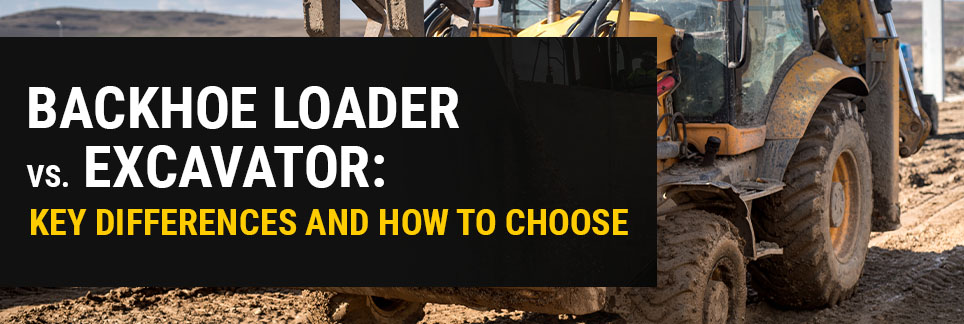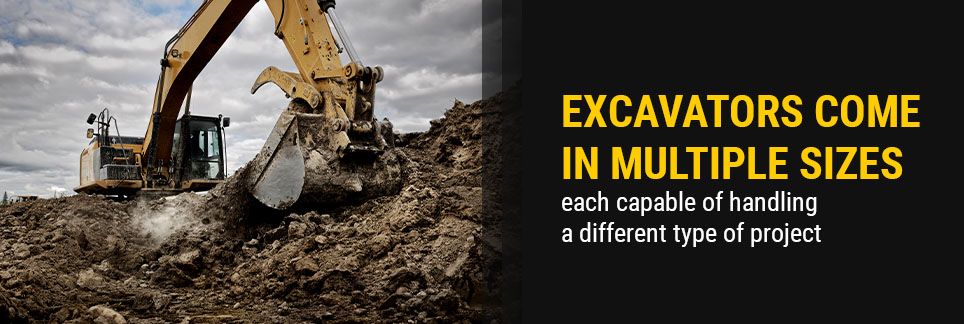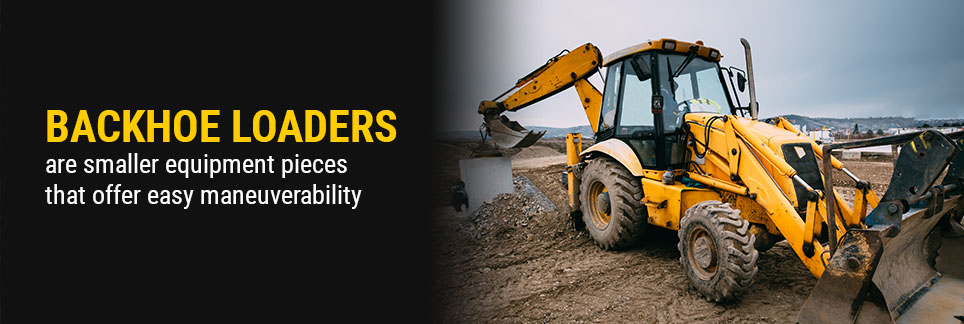
Many industries use heavy equipment to perform complex tasks and boost efficiency. Choosing the right equipment for the job is vital for your projects and ensures the longevity of your equipment. Excavators and backhoes are common pieces of equipment in construction, landscaping and agricultural uses, and they perform many similar tasks. However, there are some key differences between them that can impact your projects and productivity. Each machine has unique benefits, but choosing the right one for your application will be crucial for completing a job to the best of your ability.
At Gregory Poole, you can find the equipment and expertise you need to complete even the most complex jobs. We have new and used equipment available for purchase or rent so you can meet your needs within your budget. As a valued partner in North Carolina with a focus on great service, we’re your one-stop shop for heavy equipment. Learn more about the differences between excavators and backhoe loaders and how to choose the right equipment for your next project.
Knowing the basics about backhoe loaders and excavators can help you understand their similarities and differences.
Backhoe loaders are smaller equipment pieces that offer easy maneuverability. These machines have a boom, bucket and stick at the back end and a large front loader. Typically, backhoes can dig 12 to 16 feet deep, but some models offer as much as nearly 20 feet. They are stable, even on most uneven terrains and have a rotation limit of 200 degrees.
Backhoes are suitable for landscaping, construction and agricultural applications. You can use them to dig up trees, excavate land, transport soil or construction waste, and break up pavement. You can also find many attachments for backhoe loaders to make them suitable for various tasks, including:
These attachments help you efficiently complete projects like plowing through tough materials, penetrating frozen ground, moving odd-shaped materials, clearing snow and removing tree stumps.
Mini and heavy-duty excavators can also be versatile and efficient equipment for demanding tasks. These powerful digging machines can rotate 360 degrees and dig and dump materials. You can use excavators for pile driving, mining, dredging and breaking. They feature three major components — the undercarriage, cab, and boom and arm.
Excavators come in multiple sizes, each capable of handling a different type of project. For example, mini excavators are ideal for tight job sites, while large excavators can make quick work of commercial construction or demolition projects with hefty weight capacities.
Similar to backhoe loaders, you can also use different attachments to make an excavator more versatile. For example, you can use buckets to trench or dig, thumbs to secure materials, rippers to expedite demolition work, or augers to dig holes and trenches. Choose among other attachments to meet your project needs.
Although excavators and backhoe loaders can complete similar tasks, there are several differences between them. Understanding these differences helps you select the right equipment for your projects and use machines in the proper way to ensure longevity and productivity. There are three primary differences between backhoe loaders and excavators — size, versatility and rotation.
Your project size should always match the size of the equipment and machines you use to complete it. For large-scale projects in demolition, excavation or construction, sheer machine power is essential. Excavators are often heavier and larger than backhoes but offer less maneuverability. Many times, a standard or large excavator will be better for these applications. However, projects within a moderate scale or on smaller project sites may benefit from a backhoe. Excavators are generally more suitable for projects like driving piles, mining, demolition and drilling shafts for rock blasting, while backhoes will likely be better for loading jobs, farming, snow removal and similar medium-scale projects.
You should also note the differences in the various excavator sizes. Mini excavators weigh less than seven metric tons and are excellent for heavy-duty applications that cannot physically accommodate large excavators. This size of excavator has little to no tail swings and offers more precision than larger models. These machines do not provide as much power as their larger counterparts but can be beneficial for completing tasks like installing gas lines or underground pipes.
Standard excavators can weigh as much as 45 metric tons and are common on commercial job sites. These machines deliver power and a large hauling capacity to handle challenging jobs. Sometimes, you can find standard excavators in small or medium sizes for a more accurate idea of their capabilities. Note that although standard excavators can increase productivity in some sites, they can also damage soft soil or finished sites due to their large weight and size.
Large excavators are the heaviest of the three types. These machines are common for commercial demolition and construction projects and can aid in projects like digging foundations for shopping malls and apartments. This equipment can also move soil for civil engineering processes to boost productivity and efficiency. Transportation is most challenging with this size of excavator, but they can be incredibly valuable for heavy-duty tasks.

Although both machines are versatile in unique ways, backhoes offer a larger selection of attachments compared to excavators. The main attachments for excavators are buckets, thumbs, augers, hammers, rippers and couplers. Meanwhile, backhoe loaders can use attachments like:
This enhanced versatility makes backhoe loaders more suitable for a wide range of projects. Additionally, backhoes are often better for projects with spread-out worksites, as you can drive them on roads at speeds up to 25 miles per hour.
The last significant difference between these two machines is their range of rotation. Excavators and backhoes have different ranges, making them very different operationally. Excavators can rotate the whole of the machine’s chassis to complete a circle. Alternatively, backhoes have a range of about 200 degrees. Excavator rotation can save time on large-scale projects with the increased range of rotation, making them an excellent choice when you need to move frequently during work. However, the backhoe’s narrower rotation range makes it an exceptional piece of equipment in tight spaces as the machine is smaller and is easier to move.
Both machines have many advantages, but, like any piece of equipment, they also have their limitations. Here, we’ll explore these advantages and limitations to provide a closer look at their unique capabilities.
Generally, excavator capabilities include:
Backhoe capabilities generally include:
Like any machine, this equipment also has limitations. Limitations for backhoe loaders generally revolve around their size and power delivery. These machines are smaller, making them less ideal for large commercial projects and heavy-duty tasks. Using a backhoe loader for heavy-duty tasks could lead to a slow in productivity and potentially damage the machine, causing unexpected downtime.
You must also give careful consideration to the attachments you rent or purchase. Each machine model is unique, and every piece will fit differently. If you’re choosing a backhoe for versatility, research and identify reliable manufacturers or providers to ensure you find the attachment you need. This principle also applies to excavator attachments. No attachments are universal, so extensive research is crucial.
Excavators also have several limitations. While these machines can complete heavy-duty tasks, they are more challenging to move and offer less versatility. You cannot pair as many attachments to these machines, limiting the amount of project types you can use them for. Additionally, the large size and weight of excavators can damage soft terrain, making it essential to consider your project site conditions. Furthermore, you may experience stability concerns with some models on uneven terrain. For instance, wheeled excavators offer exceptional maneuverability but can present challenges when lifting heavy loads on uneven ground.
Although the size, versatility and rotation range will be the biggest factors for selecting the right equipment, you’ll want to consider a few other aspects:
Although your unique project will ultimately highlight a demand for the necessary equipment, there are some general tips you can follow for selecting the right machine. Take a look at these common applications to get an idea of which machine might be best for you:
You can complete large-scale demolition with excavators and small-scale demolition with backhoe loaders. Excavators are more common for demolition projects because they can handle a wide range of materials. For example, you can use excavators when dealing with wood, brick, concrete and road materials. The powerful capabilities of an excavator empower you to complete demolition projects for wood bridges and structures, masonry buildings, office buildings, apartments, industrial buildings, viaducts and roads.
Alternatively, backhoes can be beneficial for low-level building and home demolition projects. These machines will empower you to navigate tough terrain and easily relocate loose materials or dig through the ground. You can also use the bucket to haul away debris or wood scraps.

Backhoes are often more suitable for farm work tasks. The backhoe’s wheels make the machine more mobile, allowing you to cover more ground in less time. Additionally, the range of attachments makes backhoes a worthwhile investment in completing various farming-related tasks. The front bucket can move tools, crops, hay and other materials, and auger attachments can aid in laying crops or tilling. Backhoe loaders aid in many general-use tasks, but excavators can be great for some specialty farm work projects. For example, you can use an excavator to drill holes for fences or build a new structure, such as a barn.
Excavators are excellent for mining projects. Wheeled excavators can save time and improve productivity by delivering high lift capacities, low fuel consumption and maximum digging power. Large excavators are ideal for heavy lifting and earth-moving applications, making them reliable machines for mining and infrastructure construction. Excavators can move more materials with a single pass and easily clear material away from the surface, allowing teams to prepare a site quickly and begin work sooner.
With the right attachments, you may be able to use backhoes for some mining applications. For example, you can use breakers and hammers to plow through tough materials like concrete, rocks and asphalt. These attachments can make backhoes a suitable choice for back-filling mining applications.
Backhoe loaders will often be more suitable for smaller landscaping projects than excavators. Ground pressure is a crucial concern for landscaping projects, and heavy excavators can damage soft soil. Along with creating spaces for ponds and digging up trees, backhoes can also help with snow removal for landscaping projects in colder months. These machines can transport soil and materials and aid in digging trenches for irrigation lines.
However, some large landscaping projects may use excavators to place rocks or build water features or walls for heavy-duty projects. You might also benefit from using a bucket attachment on mini excavators for landscaping projects. Mini excavators can also aid in landscaping tasks like digging consistent holes for fence posts and trees or creating supports.
At Gregory Poole, you can find powerful, reliable and efficient equipment to handle the most challenging tasks. Our business has more than 70 years of experience, and our vast skills and knowledge make us a valuable partner for long-term success. We’re committed to serving business and community needs and are proud to offer the services and products you need to remain proactive and efficient.
We offer new equipment and used machines for purchase or rent to meet your project needs. Each of our machines can serve your needs while keeping you on your budget or giving you the flexibility to expand your project offerings. We also offer comprehensive services to ensure you have the support you need to foster long-term success.
Whether you need an excavator for heavy-duty tasks or a backhoe loader for a smaller-scale project, you can trust Gregory Poole to deliver the equipment necessary for your projects. Browse our equipment to find what you need or contact us for assistance choosing the right machine for your next project.